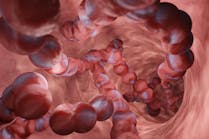To earn CEUs, see current test at
www.MLO-online.com
under the CE Tests tab.
LEARNING OBJECTIVES
Upon completion of this article, the
reader will be able to:
- discuss characteristics of hepcidin to include its structure and function;
- describe iron metabolisms and iron homeostasis;
- discuss changes in hepcidin production and clinical outcomes such as anemia of inflammation;
- list reasons for hepcidin to serve as an inflammatory marker; and
- explain laboratory and analytical issues associated with hepcidin measurements.
Find out about the mechanisms of action of hepcidin, clinical diseases resulting from aberrations in hepcidin, and its role as a putative inflammatory marker.
F
or many years, the exact mechanism of iron regulation has not been well understood. Hepcidin, a peptide produced in the liver, recently has been discovered to have a central role in iron homeostasis. It has been shown to block intestinal iron absorption, thus lowering serum iron concentrations. Hepcidin production is increased with elevated serum iron and inflammatory cytokines, particularly interleukin-6 (IL-6). Chronic inflammatory states can lead to anemia of inflammation via increased hepcidin. Conversely, mutations disrupting hepcidin production have been shown to cause hereditary hemochromatosis, a result of uninhibited iron absorption. The purpose of this review is to discuss the mechanisms of action of hepcidin, clinical diseases resulting from aberrations in hepcidin, and its role as a putative inflammatory marker.
Iron homeostasis
The body requires iron, complexed with hemoglobin within erythrocytes, to serve as the main oxygen carrier to tissue. Iron is also essential to cytochromes present within the mitochondrial electron transport chain. Erthryocytes are constantly being formed and degraded with an average life span of approximately 120 days. Despite the large volume of erythrocyte turnover, iron is sufficiently recycled such that only one to two milligrams of dietary iron per day are needed to maintain the body’s approximate two to four grams of total iron. Enterocytes lining the small intestine initially absorb iron via an iron transporter, DMT1. Iron must be absorbed in its reduced state, Fe2+, to pass through the transporter. Iron found from animal sources is directly absorbed; however, iron found from plant sources must first be reduced from Fe3+ to Fe2+ by a duodenal cytochrome b1 (DCytb1) prior to absorption (see Figure 1).
Once inside the enterocyte, iron is transported to the basolateral side of the cell where iron can be transported out of the cell into the blood. This transport is achieved by another transmembrane transporter termed ferroportin. Iron is then bound by the plasma protein transferrin, which serves as the source of iron for erythropoeisis and cellular respiration, taken up into cells expressing the transferrin receptor.
Ferroportin is also expressed in macrophages that have engulfed and degraded senescent erythrocytes. Ferroportin allows the macrophages to release iron so that it may be re-utilized for ongoing erythropoeisis. Hepatocytes also express ferroportin.
Hepcidin, a peptide produced by the liver and encoded by the HAMP gene, has been found to play a central role in iron metabolism and homeostasis.1 Hepcidin production is upregulated with increased serum iron and then blocks iron transport through the ferroportin channel in enterocytes and macrophages, thus decreasing the amount of iron released into the blood. The iron is then either trapped in the enterocytes and sloughed into the gastrointestinal tract, or it is trapped in the macrophages of the reticuloendothelial system. Mouse macrophage cell cultures incubated with hepcidin show that expression of ferroportin itself is reduced several hours after incubation.2
Alterations in hepcidin production and clinical outcomes
Distinct clinical outcomes result from either too little hepcidin or too much hepcidin. Anemia of inflammation is a disorder that develops following prolonged periods of inflammation and is broadly characterized by low serum iron, low to normal transferrin, and high ferritin. There are numerous examples of clinical conditions that lead to a chronic inflammatory state, including rheumatologic autoimmune diseases, malignancies, and infections. The common feature in these diseases is production of inflammatory cytokines, such as interleukin 6 (IL-6), tumor necrosis factor-alpha (TNF-alpha), and bone morphogenic protein (BMP). Elevated levels of cytokines IL-6 have been shown to increase hepcidin levels even hours after administration.3 BMP has also been shown to raise hepcidin production in mice, independent of IL-6 function.4 Chronic elevation of these inflammatory cytokines, particularly IL-6, has consistently been shown to raise hepcidin levels. This subsequently acts on the ferroportin iron transporter, and inhibits iron release into the bloodstream from enterocytes and macrophages. One possible rationale for this biologic mechanism is to sequester iron and reduce iron availability for microbial metabolism. It has also been shown that high levels of hepcidin have antimicrobial activity,5 and it is thought that cytokine-mediated hepcidin release during infection is part of the body’s defense against microbes. Ultimately, anemia of inflammation results and is generally not responsive to oral iron intake, as intestinal absorption is blocked via hepcidin.
Traditionally, medical therapies aimed at treating anemia of inflammation include high doses of erythropoietin and iron intake. The bone marrow appears to be less responsive to erythropoietin stimulated red cell production, so higher doses of erythropoietin are generally needed to overcome this. Also, as the mechanism of reduced serum iron is related to hepcidin-mediated blockade of intestinal iron absorption, parenteral iron administration may be required to improve serum iron levels if high doses of oral iron are ineffective. Alternatively, new methods at cytokine blockade may be beneficial, as in TNF-alpha blockade currently in use for rheumatoid arthritis. Newer therapies aimed at blocking hepcidin-mediated anemia are currently being evaluated in animal models. Mice with anemia of inflammation treated with anti-hepcidin antibodies showed improvement of anemia.6 In cases of hepcidin-producing liver tumors causing anemia, surgical tumor resection was followed by spontaneous normalization of anemia.7
Figure 1. Iron homeostasis and regulation in an enterocyte and macrophage.
Elemental iron absorption occurs in intestinal epithelial cells (enterocytes) in the duodenum. Epithelial cells mature up the villus axis about 7 days only to be sloughed off at the tip. Iron is then transported into the blood through ferroportin (FPN) or lost with the sloughed enterocyte. Macrophages and cells expressing transferrin receptor-1 (TfR-1) internalize the transferrin-iron complex. Iron is released within the vesicles and will either be stored within the cell complexed with ferritin, or will be released into the blood through the ferroportin channel. Hepcidin prevents ferroportin mediated release of iron.
Conversely, when gene mutations occur in the hemochromatosis iron protein (HFE), hemojuvelin, or hepcidin; hepcidin production is knocked out or reduced. Hepcidin then is not available to block iron transport through the ferroportin channel into the bloodstream. As the body does not have an effective mechanism to dispose of excess iron, the iron is deposited throughout the body. The iron-overload syndrome known as hemochromatosis then develops, leading to complications such as liver failure with cirrhosis, constrictive cardiomyopathy, gray discoloration of the skin, and diabetes from pancreatic dysfunction.
Mutations directly involving the hepcidin HAMP gene account for a small percentage of cases,8 indicating that mutations in hepcidin regulatory genes are mainly implicated. These affect the expression of hepcidin, leading to clinical hemochromatosis. Indeed, HFE is responsible for transcriptional regulation of hepcidin.9 Patients with HFE-hemochromatosis (most commonly due to C282Y mutations) have decreased hepcidin/ferritin ratios compared to normal patients, indicative of inappropriately low hepcidin in the face of elevated iron stores. Iron challenge in these patients increases urinary hepcidin in an incremental fashion according to their HFE homozygous, heterozygous, or wild-type gene status; this supports hepcidin production regulation by iron levels.10 Several studies have suggested that hepcidin production is decreased in hereditary hemochromatosis with HFE mutations due to defective BMP or BMP blockade.11,12
Mutations in the ferroportin gene render the ferroportin iron transporter unresponsive to hepcidin and may also lead to hemochromatosis. Although the exact function of transferrin binding protein transferrin receptor 2 (TfR2) is not fully known, homozygous mutations are also a cause of hereditary hemochromatosis.13 In mice with homozygous mutations in TfR2 (TfR2 -/-), introduction of TfR2 gene via a viral vector increased hepcidin levels and decreased transferrin levels compared to control mice, thus supporting a role in hepcidin regulation.14
While classic treatment for hemochromatosis includes therapeutic phlebotomies to rid the body of excess iron, knowledge of the role of hepcidin may aid treatment in the future. In mice with HFE -/- hemochromatosis, daily administration of purified hepcidin for two months normalized serum iron levels.2 While the hepcidin administration did reduce serum iron, hepatic and tissue iron stores did not decrease during the two-month treatment course, consistent with hepcidin trapping iron in hepatocytes and macrophages via ferroportin blockade. Whether hepcidin can be eventually used as a treatment for hemochromatosis remains to be determined.
Hepcidin as an inflammatory marker
As previously mentioned, hepcidin levels have been shown to be increased as a result of inflammation and may have antimicrobial activity. Additionally, hepcidin itself may serve as an inflammatory marker. Patients with renal transplants frequently develop coronary artery disease (CAD), a condition that is considered an inflammatory state. Patients with renal transplants were found to have higher levels of hepcidin in those with CAD than those without, and the higher levels of hepcidin also correlated with higher levels of known inflammatory markers.15 Other patients with renal failure receiving hemodialysis had higher mean hepcidin levels compared to controls. Hepcidin levels were reduced following hemodialysis16 but returned to baseline levels within one hour following hemodialysis.17 Elevated hepcidin levels correlated with elevated C-reactive protein and IL-6, yet hepcidin was also elevated in a subset of hemodialysis patients without microinflammation and correlated with ferritin.17 Another study of patient’s with Hodgkin’s lymphoma found a significant correlation between elevated IL-6 levels with hepcidin but not with other cytokines IL-10 and thymus and activation-regulated cytokine (TARC).18 Hepcidin was also significantly correlated with increased fibrinogen, another known acute-phase reactant.
Analytical issues
As the clinical relevance of hepcidin has become apparent, refinement and standardization of hepcidin analysis is essential. There are multiple methods currently employed by different laboratories to measure hepcidin levels, including weak cation exchange chromatography, time-of-flight mass spectrometry (TOFMS), and immunochemical methods.18-20 A recent study by Kroot, et al, looked at the correlation of hepcidin levels of 15 samples from urine and plasma sent to different laboratories in six different countries.20 Samples were taken from both healthy subjects and patient subjects, and covered a wide range of hepcidin concentrations. Different methods used in the analysis included both mass spectrometry and immunochemical methods. Samples were tested in replicates and showed generally fair precision within each specific method, yet concordance with lab values obtained from different laboratories showed considerable variation. For example, one sample’s values ranged from 11.6 nmol to 1646.9 nmol hepcidin/nmol creatinine. This problem exemplifies that hepcidin measurement has not been standardized and may be due to a number of causes, including assay differences and different calibration solutions. Therefore, comparing hepcidin levels from different laboratories must currently be analyzed within the context of the laboratories’ reference ranges.
Immunoassays have shown some difficulty in anti-hepcidin reagents as the hepcidin molecule is rather small (25 amino acids). Additionally, antibody development is challenged by hepcidin conservation among animal species. Efforts at improving reproducibility by spiking a urine or serum sample with synthetic hepcidin-24 are currently being studied for TOFMS.19 This method allows for hepcidin-24 to serve as an internal control to better account for hepcidin-25 variability following sample processing.
Conclusion
Hepcidin is a small protein produced in the liver that has emerged as a central regulator of iron homeostasis. It prevents iron release into the bloodstream by blocking the iron transporter ferroportin, present on the basolateral surface of enterocytes as well as macrophages and hepatocytes. Iron is then either shed with the enterocytes in the gastrointestinal tract or trapped within macrophages and hepatocytes.
Hepcidin production is upregulated in response to iron deficiency and inflammatory cytokines, particulary IL-6. Diseases with chronic elevation of inflammatory cytokines (e.g., rheumatologic disorders, malignancies, inflammatory bowel disease, and others) lead to hepcidin upregulation and, consequently, anemia of inflammation. Conversely, mutations in hepcidin regulatory genes HFE and hemojuvelin in which hepcidin production is inhibited or knocked out, lead to the iron-overload condition: hereditary hemochromatosis. Efforts at mitigating the over-production or under-production of hepcidin via IL-6 blockade or hepcidin infusion may prove useful in the future in the treatment of anemia of inflammation and hereditary hemochromatosis, respectively.
Last, laboratory measurement of hepcidin is currently not standardized. Although values within method may be reasonably reproducible, hepcidin measurements between different institutions are not currently comparable. Studies to improve standardization and improve methods for hepcidin measurements are needed.
Judith Robens, MD, is currently a member of the anatomic and clinical pathology residency training program at Beth Israel Deaconess Medical Center and Harvard Medical School. She completed her doctorate of medicine at the University of Miami Miller School of Medicine in 2007.
References
- Ganz T. Hepcidin—a regulator of intestinal iron absorption and iron recycling by macrophages. Best Practice & Research Clinical Haematology. 2005;18(2):171-182.
- Moran-Jimenez M, Mendez M, Santiago B, et al. Hepcidin treatment in Hfe -/- mice diminishes plasma iron without affecting erythropoiesis. Eur J Clin Invest. 2010;40(6):511-517.
- Sasu BJ, Cooke KS, Arvedson TL, et al. Antihepcidin antibody treatment modulates iron metabolism and is effective in a mouse model of inflammation induced anemia. Blood. 2010; 115(17):3636-3624.
- Majore S, Binni F, Ricerca BM, et al. Absence of hepcidin gene mutations in 10 Italian patients with primary iron overload. Haematologica. 2002;87(2):221-222.
- De Domenico I, Ward DM, Kaplan J. Hepcidin regulation: ironing out the details. J Clin Invest. 2007; 117:1755-1758.
- A Piperno A, Girelli D, Nemeth E, et al. Blunted hepcidin response to oral iron challenge in HFE-related hemochromatosis. Blood. 2007;110(12):4096-4100.
- Ryan J, Ryan E, Fabre A, et al. Defective Bone Morphogenic Protein Signaling Underlies Hepcidin Deficiency in HFE Hereditary Hemochromatosis [published online ahead of print June 30, 2010]. Hepatology.
- Nili m, Shinde u, Rotwein p. Soluble repulsive guidance molecule c/hemojuvelin is a broad spectrum bone morphogenetic protein (BMP) antagonist and inhibits both BMP2- and BMP6-mediated signaling and gene expression. J Biol Chem. 2010;285(32):24783-24792.
- Camaschella c, Roetto a, Cali A, et al. The gene TFR2 is mutated in a new type of haemochromatosis mapping to 7q22. Nat Genet. 2000;25:14-15.
- Gao J, Chen J, De Domenico I, et al. Hepatocyte-targeted HFE and TFR2 control hepcidin expression in mice. Blood. 2010;115(16):3374-3381.
- Malyszko J, Malyszko JS, Pawlak K, et al. Hepcidin, an Acute-Phase Protein and a marker of inflammation in kidney transplant recipients with and without coronary artery disease. Transplantation Proceedings. 2006;38:2895-2898.
- Zaritsky J, Young B, Gales B, et al. Reduction of Serum Hepcidin by Hemodialysis in Pediatric and Adult Patients [published online ahead of print March 18, 2010]. Clin J Am Soc Neprol. 2010;5(6):1010-1014.
- Kuragano T, Shimonaka Y, Kida A, et al. Determinants of Hepcidin in patients on maintenance hemodialysis: role of inflammation. Am J Nephrol. 2010;14:31(6):534-540.
- Hohaus S, Massini G, Giachelia M, et al. Anemia in Hodgkin’s Lymphoma: The Role of Interleukin-6 and Hepcidin [published online ahead of print April 2010]. Journal of Clinical Oncology. 2010;28(15):2538-2543.
- Swinkels DW, Girelli D, Laarakkers C, et al. Advances in quantitative hepcidin measurements by time-of-flight mass spectrometry. PLoS One. 2008;3(7);e2706-E2712.
- Kroot J, Kemma E, Bansal S, et al. Results of the first international round robin for the quantitation of urinary and plasma hepcidin assays: need for standardization. Hematologica. 2009;94(12);1748-1752.
- Krause A, Neitz S, Magert HJ, et al. LEAP-1, a novel highly disulfide-bonded human peptide, exhibits antimicrobial activity. FEBS Letter. 2000;480:147-150.
- Nemeth E, Rivera S, Gabayan V, et al. IL-6 mediates hypoferremia of inflammation by inducing the synthesis of the iron regualatory hormone hepcidin. J Clin Invest. 2004;113(9):1271-1276.
- Truksa J, Peng H, Lee P, et al. Bone morphogenetic proteins 2, 4, and 9 stimulate murine hepcidin 1 expression independently of Hfe, transferring receptor 2 (Tfr2), and IL-6. Proc Natl Acad Sci USA. 2006; 103:10289-10293.
- Weinstein DA, Roy C, Fleming M, et al. Inappropriate expression of hepcidin is associated with iron refractory anemia: implications for the anemia of chronic disease. Blood. 2002;100(N10);3776-3781.






